First post, by iosys
Hello,
I'm having more and more difficulty finding functional AT power supplies.
More and more PSUs are failing over time.
I was wondering if there were any plans to build one viable, 200-250W. in a DIY way.
Hello,
I'm having more and more difficulty finding functional AT power supplies.
More and more PSUs are failing over time.
I was wondering if there were any plans to build one viable, 200-250W. in a DIY way.
I know it's a fun project. But other than that, any reason why not to use ATX PSUs with ATX->AT converters?
But it is too economical to adapt a commodity ATX supply to power an AT system instead. There are even "smart" converters with soft fuses and such to help protect the old hardware against short circuits, and that supply -5V.
Perhaps if ATX12VO supplies displace all the others, it will make sense to build a converter that does the 12V to +-12V and +-5V conversion, as well as soft fuse functionality and providing "Molex" and "floppy" power connectors as those are disappearing from ATX supplies anyway. If you have to do the conversion anyway, wouldn't this avoid the 5V early Athlon power issue as well.
There could also be safety reasons for hobbyists not working with 120VAC/240VAC... "X" vs "Y" type capacitors for example. I know very little about it myself.
wbahnassi wrote on 2023-09-07, 00:22:I know it's a fun project. But other than that, any reason why not to use ATX PSUs with ATX->AT converters?
Le'me guess. Maybe someone feels potentially threatened to be kicked out of silicon heaven because of partial "period incorrectness" using ATX instead of AT PSU 😁 😁 😁
I still have two old AT power supplies from the early '90s, but I don't bother to repair them - at the very least they need the capacitors replaced. For my old 386 system I just use an early 2000s ATX PSU with the cheapest chinese ATX-to-AT adapter and it works with no problems.
from СМ630 to Ryzen gen. 3
engineer's five pennies: this world goes south since everything's run by financiers and economists
this isn't voice chat, yet some people, overusing online communications, "talk" and "hear voices"
Agree ! Ok sure you can build one (the board and parts from scratch) but what are you going to put it in ? You would need a metal case (like from old PSU) to put it in.
Better to rebuild a used AT PSU then try to start from scratch besides the price to build one from scratch on small scale would be huge ! Could end up $100+$100
Generally old AT PSU just need caps replaced.........just my opinion. Am thinking of one for Athlons or P3 that need a very heavy 5+ amperage, cannot get that easy with an ATX
Hate posting a reply and then have to edit it because it made no sense 😁 First computer was an IBM 3270 workstation with CGA monitor. Stuff: https://archive.org/details/@horun
My goal would be only to replace the PCB, starting from existing old AT case.
I try to keep the most of originals parts.
Maybe I try to integrate an ATX PCB in AT case... But yes, ATX PSUs give all their power on the +12v rail.. Not the +5v
replace capacitors would be good IDEA, but usually, modern caps are more huge than original ones. And PSUs got such a lot of them...
Also found the ATX2AT project but it is way too much advanced for my way of restoring old hardware.
Anyway, thank you for your ideas 😀
iosys wrote on 2023-09-07, 21:13:But yes, ATX PSUs give all their power on the +12v rail.. Not the +5v
Hmm, I don't know what you mean by this, but all modern ATX 3.0 do deliver 5V, 3.3 and 12V as well as 5Vsb. What they do lack is -12V and deliver most of their power to 12V and 5V is significantly weaker compared to early 2000s ATX PSUs. However, weak 5V is pretty much an issue only with many Socket A builds, which may require around 30A on 5V line depending on the configuration.
replace capacitors would be good IDEA, but usually, modern caps are more huge than original ones. And PSUs got such a lot of them...
This is not exactly true either, at least when we are talking about electrolytic caps used in the secondary side and primary shouldn't be a problem either. I'd say it is more or less the opposite and many equivalent or more so better modern caps I've used are in many cases at least shorter than the ones they replace. Sometimes you find similar or better cap with, for example, 8mm diameter while original is 10mm.
I haven't yet recapped a single AT PSU, but recently did two 5V heavy Enermax ATX supplies from early 2000s. I had zero problems finding low ESR caps for them which fit nicely on these tightly populated PSU boards. I've used mainly Panasonic FR series and with some occasional other Panasonic type and few odd Rubycons here and there. Choice of capacitors is based on the size and capacitor specs (ripple, ESR, capacitance, voltage). Most caps in the secondary side on these PSUs were originally pretty much general purpose or at best very low end low ESR/high ripple ones, so you don't need to use polymers with these like with some motherboard VRM caps from the same era.
As I said, I haven't recapped AT PSUs, but I don't see why they would be that much different from these. And AT PSUs have generally much fewer caps than these newer ATX supplies.
CharlieFoxtrot wrote on 2023-09-08, 06:13:I haven't yet recapped a single AT PSU, but recently did two 5V heavy Enermax ATX supplies from early 2000s. I had zero problems finding low ESR caps for them which fit nicely on these tightly populated PSU boards. I've used mainly Panasonic FR series and with some occasional other Panasonic type and few odd Rubycons here and there. Choice of capacitors is based on the size and capacitor specs (ripple, ESR, capacitance, voltage). Most caps in the secondary side on these PSUs were originally pretty much general purpose or at best very low end low ESR/high ripple ones, so you don't need to use polymers with these like with some motherboard VRM caps from the same era.
As I said, I haven't recapped AT PSUs, but I don't see why they would be that much different from these. And AT PSUs have generally much fewer caps than these newer ATX supplies.
I'd say AT units are even easier to recap, they're usually more sparsely populated and not as cramped to work in, which also means that you don't need those rare tall and thin custom-made capacitors used in some ATX units. I find that Rubycon YXF series or equivalent is ideal for those old AT power supplies.
TheMobRules wrote on 2023-09-08, 06:54:I'd say AT units are even easier to recap, they're usually more sparsely populated and not as cramped to work in, which also means that you don't need those rare tall and thin custom-made capacitors used in some ATX units. I find that Rubycon YXF series or equivalent is ideal for those old AT power supplies.
Exactly. What I've inspected AT supplies I have, secondary side has like generally handful to 10-ish capacitors and boards have generally much more room, so slightly bigger caps aren't even usually an issue. On the otherhand, these ATX supplies had probably roughly 20 caps and especially high capacitance caps on the output were packed right next to each other, which means that going from original 10mm to 12,5 mm isn't possible, for example. And height is rarely an issue at all, at least as long as you are roughly on the ball park. Still, I had no trouble finding caps with equal or smaller physical size that fulfill the specs of original caps and are actually better than the originals (higher ripple current capability, for example).
This will either be expensive if you use standard winding products (transformers) or non-repeatable.
If you make one main converter for +5V 30-40Amp and the rest are DC/DC, then the price will be the same as the new Seasonic Platinum.
Aopen MX3S, PIII-S Tualatin 1133, Radeon 9800Pro@XT BIOS, Diamond monster sound MX300
JetWay K8T8AS, Athlon DH-E6 3000+, Radeon HD2600Pro AGP, Audigy 2 Value
I had to dig up a unit seeing this thread. In 90s Eastern block among all the Taiwanese and Chinese parts there were the oddball units also. Made in small volumes, somewhat looks homebrewn but well made. Standard small AT chassis. Some extra voltage rails for special equipment power.
Like this one:
It had a separate controller board that is lost. Probably configured with the classic TL494 and LM339 ic.
Making a half bridge topology supply involving the math, circuit design and winding the transformers, maybe something off the shelf... all the safety standards... too much trouble.
Some 5- 6 years ago we had to get a bunch AT units for some non replaceable critical systems. Got those from Conrad I think. Just get FSP SPI-250G if you can. I see them from time to time on Ebay though bit pricy.
It would be cool if some hardcore retro enthusiasts/engineers come up with a beefy all purpose AT unit.
TheMobRules wrote on 2023-09-08, 06:54:I'd say AT units are even easier to recap, they're usually more sparsely populated and not as cramped to work in, which also means that you don't need those rare tall and thin custom-made capacitors used in some ATX units. I find that Rubycon YXF series or equivalent is ideal for those old AT power supplies.
Agree !! The early ATX were/are horrid for finding them super slim replacement caps, not so with the AT's !
Hate posting a reply and then have to edit it because it made no sense 😁 First computer was an IBM 3270 workstation with CGA monitor. Stuff: https://archive.org/details/@horun
Honestly, the bigger problem is finding old cases! ATX supplies can be converted to AT. But there's no modern replacement for vintage computer cases, the ones that actually looked nice.
There are some nice looking modern cases, but they certainly don't evoke the spirit of the 1980s.
World's foremost 486 enjoyer.
OK Folks !
I found a new way to build AT power supply from ATX, keeping maximum AT PSU parts...
I simply started with an ATX PSU with -5v and -12v (very easy to find for me).
Started with this old ATX PSU :
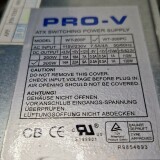
To replace PCB from this AT PSU whom +12v where showing 9,5v (after replacing capacitors) :
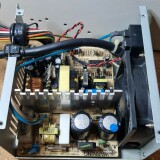
Desoldered all cables from ATX PCB, and put connectors for +220v and fan :

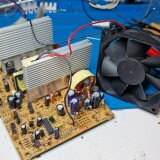
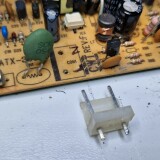
Problem 🙁 heatsink is right in the path of the switch cable...
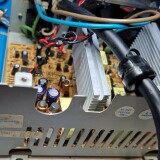
Lets bend this a little to fit purfectly 😀 :
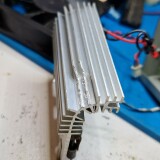
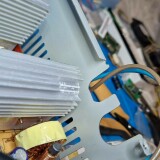
Then finishing by soldering old AT power cables on the ATX PCB (and not forgetting to short PSU ON pinout with GND directly on the PCB) :
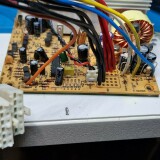
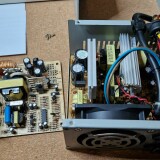
Only 3.3V cables where not put in place in the AT PSU.